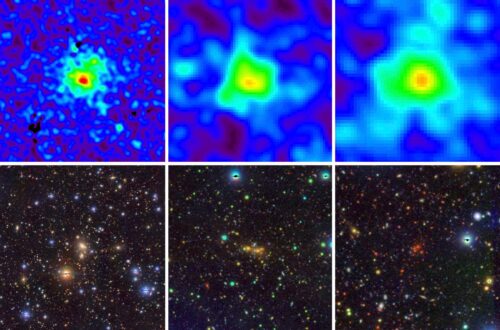
Above: X-rays of galaxy clusters, below optical images of the same clusters. Credit: eRosita.com
Observations with the German eROSITA X-ray telescope in space seem to indicate that dark energy is evenly distributed in space, just as astronomers already thought. Three quarters of all the mass energy of the universe is formed by this mysterious dark energy, the rest is dark matter (20% and ordinary matter (5%). In the late 1920s, Hubble and Lemaître discover that the universe is expanding and discovers in 1998 two independent teams that the universe accelerated expansion, something dark energy with a kind of anti-gravity is responsible for. More than a hundred years ago, Einstein said that there was something that could counteract the gravitational pull of matter in the universe, something he called the cosmological constant (Λ, Lambda). In 1998 it was proposed that dark energy is nothing more than this cosmological constant and is evenly distributed in space and constant in time, a discovery for which they were awarded the Nobel Prize in 2011. The same cannot be said for dark matter, which is very irregularly distributed, with concentrations in the halos around galaxies and lower densities in the voids between (clusters of) galaxies.
But is this dark energy really as evenly distributed as claimed? This is what I-Non Chiu (Taiwan University) and his colleagues wondered, and to find out they started studying galaxy clusters in the universe. Dark energy antigravity does not work on the small scale of stars and galaxies, but on the very large scale of galaxy clusters and the universe itself. That’s why they started looking at clusters, which have masses of 10^13 to 10^15 times that of the sun, very large masses. Together with the aforementioned eROSITA space telescope, which was launched in 2019, they have, as part of the ‘Final Equatorial Depth Survey eROSITA (eFEDS)’ imaged clusters of galaxies. They found 500 of these clusters, which dated back ten billion years in time. When data from eFEDS were combined with data from the ‘Hyper Suprime-Cam Subaru Strategic Program‘ they could see what influence dark energy had on these clusters. It turned out that 76% of the total energy of the mass is formed by dark energy and that it is evenly distributed in space and remains constant over time, as claimed in 1998.
More information can be found in the article by I-Non Chiu et al, Cosmological Constraints of Galaxy Clusters and Groups in the Final Equatorial Depth Survey eROSITA, Royal Astronomical Society Monthly Notices (2023).
Source: Phys.org.
Related Astroblogs

“Food expert. Unapologetic bacon maven. Beer enthusiast. Pop cultureaholic. General travel scholar. Total internet buff.”
 DodoFinance Breaking News Made For You!
DodoFinance Breaking News Made For You!
